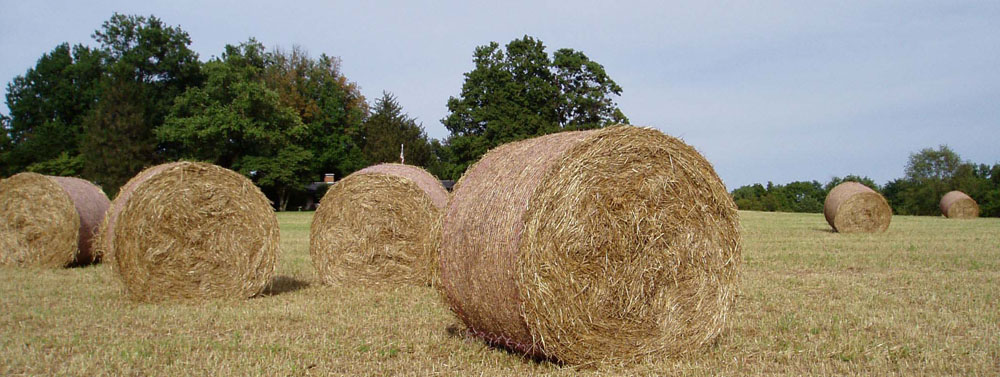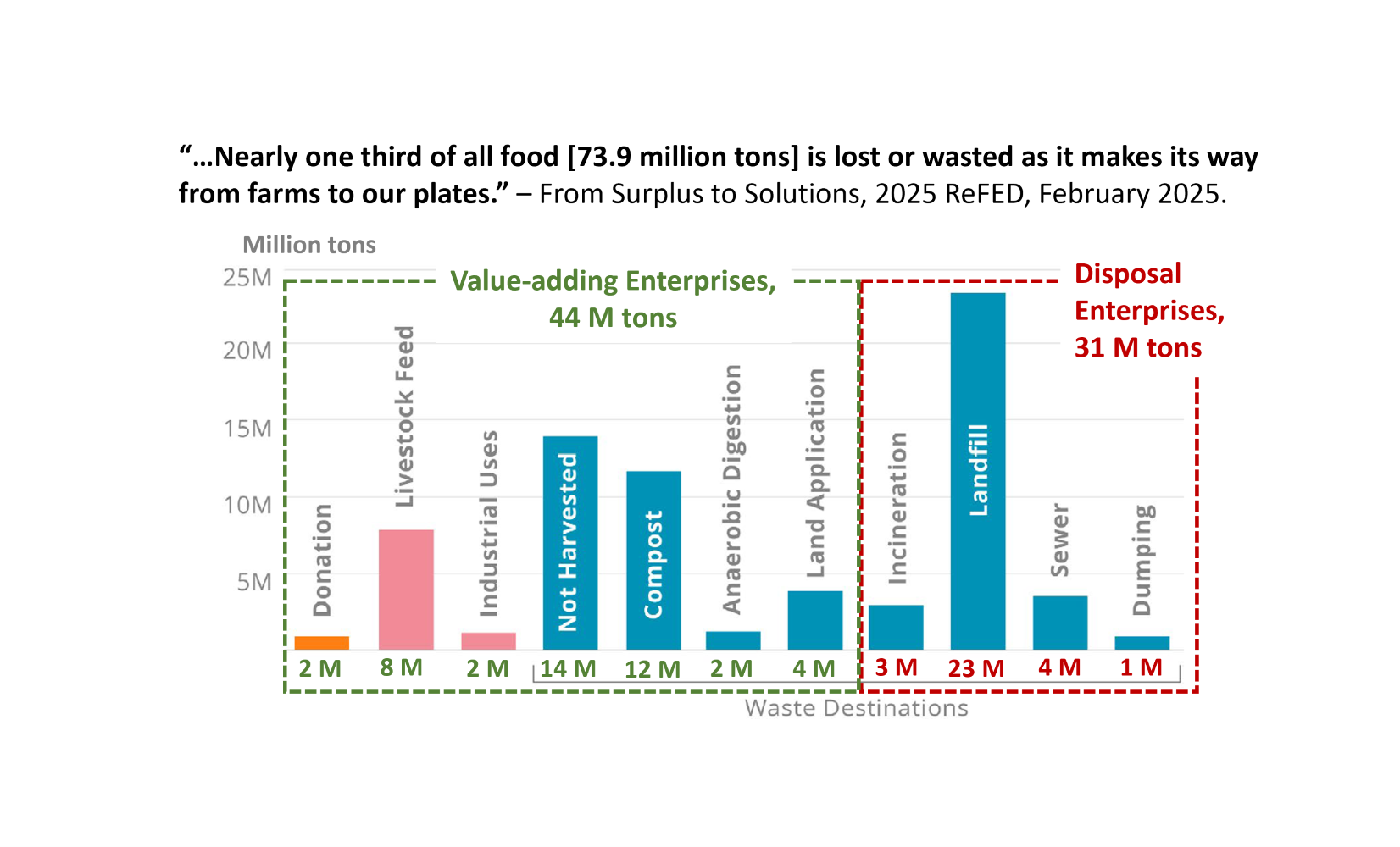Managing the Cost of Food Waste Inflation
Biomass Rules operates at the intersection of production agricultural food production and opportunities to bring value-adding, agricultural byproducts back into the economy through reuse. The moving target for value-adding byproducts is the pool of undervalued wastes. The knowledge of agricultural markets, supply chains, and infrastructure is applied to wasted resources and magic happens.
The release of the 2025 ReFED, Surplus to Solutions last month did not look what I would expect a food waste repurposing report to appear. It was surprising that value-adding industry champions like the composting and biogas industries embraced this report. But we all see new data through our own lenses.
The 2025 ReFED report is well done and the result of years of work and a significant network of collaborators. I am grateful for the clarity of their analysis for me to begin to take a more focused look at food waste and what is getting evaluated. But the definitions used in the ReFED overstate and inflate the quantity of food wasted in the US. This methodology is harmful to the fragile confidence of consumers in the safety and effectiveness of the US food industry.
There are three parts to what has been reported that do not fit the Biomass Rules value-adding framework.
- The inclusion of losses from field to retail. USDA does great work on evaluating things like pre-season, intended apple production compared to total apples produced and how many apples get eaten. This is an important analysis when asking what is happening to apples. No one wants these losses. There is no benefit from chickens dying from bird flu. Everyone in these industries is working furiously to lose less money with these unwanted losses. Often these losses move into other markets and are not completely lost.
- The numbers of production losses, food expiration labeling questions, and unfinished plate scrapings are summed into a category of ‘Surplus Food’. Once food can no longer be eaten, it is not food. Inedible food is not a surplus.
- Just because a crop, corn or soybeans, was intended for a role in the food production system – and it did not turn into food – does not mean it is a waste. Food production intentions minus Food consumption DOES NOT EQUAL FOOD WASTE.
The US food production system is incredibly complicated. Soybeans are nearly all divided into the two principal market channels of soybean meal for protein (82 percent of the bean), and a much higher valued oil (18 percent of the bean). Traditionally, soybean oil was food, but it has become a feedstock for biodiesel fuel in the last 20 years. What part of the bean is food? It gets much more difficult as the meal that is largely livestock feed, is also refined into other higher valued, human food products.
Soybeans go into food markets, biofuel markets, and animal feed markets. Even more complicated is that the soybean food waste, used vegetable oil, has become popular as a feedstock into biodiesel fuel. In 2024, most of the 8 billion pounds of used cooking oil, used in fuel, was imported from other countries.
ReFED estimates that 73.9 million tons of surplus food was generated in 2023. This chart from page 2 of their report illustrates that 85 percent of the 74 million tons went to waste destinations.
For Biomass Rules, the first seven categories are all value-adding or cost offsetting uses that are not disposal costs. These are simply alternate pathways for underutilized agricultural products. The individual category amounts were not provided in the report and are approximated from the chart (so some rounding errors).
- Donated food that could not be sold, 2 million tons. Excellent!
- Food repurposed in livestock feed, 8 million tons. Also, great job!
- Industrial uses, 2 million tons. This is likely similar to moving used cooking oil into fuel and lubricants.
- Not harvested, 14 million tons. As indicated in point number 1 above, no one plants a crop not to harvest it. There are many reasons for this: weather, labor shortages, in field damage, and sometimes, market shifts. These unexpected outcomes are not total losses. The nutrients get recycled in the next crop and the wildlife get fed. This is not the same challenge presented by expiration label confusion or plate scrapings. Not harvesting is not the intended use.
- Composting, 12 million tons. I have had the privilege of watching the composting industry change the world, adding value to unwanted and undervalued waste resources. Compost is quite valuable, often more valuable than a bushel of corn. It is not a waste.
- Anaerobic digestion, 2 million tons. This value estimate is woefully low. While at the UC Davis, California Biomass Collaborative fifteen years ago, we were working with food processing residuals for feedstocks into digesters. It has taken 50 years of development, but today, the US biogas industry is recognized as a viable industry.
- Land application, 4 million tons. Land applied food byproducts are supported by the food production market infrastructure. These materials are not wasted.
The last four categories: incineration, landfills, sewers, and dumping; point to the regulated nature of organic wastes. The environmental laws were put in place to protect human health, wildlife, and natural water ways. Without the first, left-most 10 categories, the 73.9 million tons would have been dumped into the environment. As presented, dumping is the lowest category presented (less than 2 million tons).
According to my chart-derived quantities, 44 million tons are recovered into the economy as something other than food. It is transformed into something other than food waste, and no longer eligible to be labeled as food waste. The remaining disposal methods account for 31 million tons, or less than half of the 74 million tons identified by ReFED as lost or wasted food.
I got into agriculture primarily because it was clear in the 1970s that we needed more food. Even in the 2020s, our US and global food systems are very fragile. Five years ago, at the onset of the pandemic and into the first year, there were food shortages in the US. For forty years, I have been exploring alternative markets for food and agricultural products. Often barriers to change are hidden.
Food is wasted. We can and must do better. But even premature food expiration and excessive plate scrapings have food safety and over-eating reduction benefits. There are costs to inflating the food waste target, and no benefit to overcounting wasted food.



Comments
Managing the Cost of Food Waste Inflation — No Comments
HTML tags allowed in your comment: <a href="" title=""> <abbr title=""> <acronym title=""> <b> <blockquote cite=""> <cite> <code> <del datetime=""> <em> <i> <q cite=""> <s> <strike> <strong>